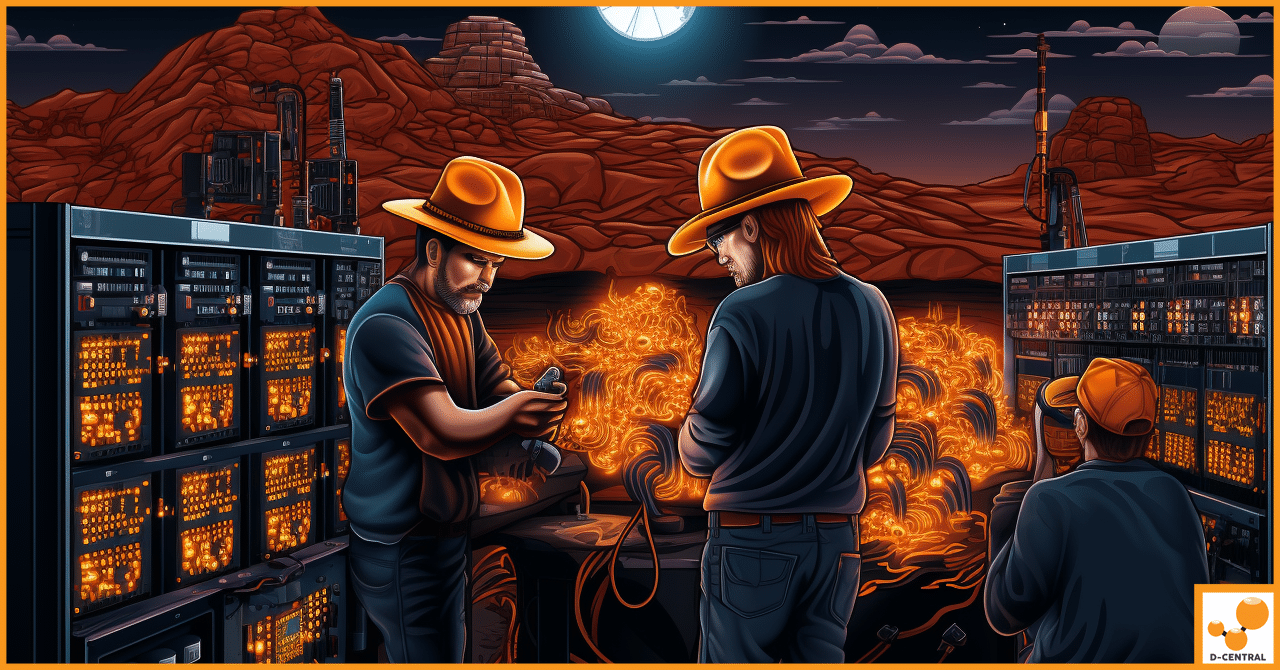
Unlock Home Mining with the 120V Antminer Slim Edition
Discover how the 120V Antminer Slim Edition is transforming the landscape of home cryptocurrency mining. Designed specifically for residential use,
4479 Desserte Nord Autoroute 440, Laval, QC H7P 6E2

Bitcoin mining has emerged as a cornerstone activity in the cryptocurrency world, playing a pivotal role in both the creation of new bitcoins and the maintenance of the network’s security and integrity. At its core, Bitcoin mining involves solving complex cryptographic puzzles, a process that not only facilitates the addition of new transactions to the Bitcoin blockchain but also leads to the minting of new bitcoins as a reward for the miners. This dual role underscores the critical importance of mining in the Bitcoin ecosystem, ensuring both the steady growth and the robust security of the network.
The journey of Bitcoin mining hardware has been a fascinating one, marked by rapid technological advancements and increasing specialization. In the early days of Bitcoin, mining was a relatively simple affair, with miners using standard Central Processing Units (CPUs) found in everyday personal computers. This accessibility meant that virtually anyone with a computer could participate in mining, democratizing the process. However, as Bitcoin grew in popularity and value, the mining landscape began to evolve.
The quest for more efficient mining led to the adoption of Graphics Processing Units (GPUs), which offered significantly higher processing power compared to CPUs. This shift marked the first major leap in mining technology, but it was just the beginning. The relentless pursuit of efficiency and speed soon gave birth to Application-Specific Integrated Circuits (ASICs), specialized hardware designed exclusively for Bitcoin mining. These ASICs represented a quantum leap in terms of mining capability, offering unparalleled hash rates and energy efficiency compared to their predecessors.
The evolution from CPUs to ASICs is not just a tale of technological advancement; it reflects the growing complexity and competitiveness of Bitcoin mining. As the difficulty of mining puzzles increased and the rewards became more lucrative, the need for more powerful and efficient hardware became paramount. Today, ASICs dominate the mining landscape, and choosing the right hardware has become a critical decision for anyone serious about mining Bitcoin.
Bitcoin mining is the backbone of the Bitcoin network, serving a dual purpose: it is the process by which new bitcoins are introduced into the system, and it is essential for maintaining and securing the blockchain. Mining involves the use of sophisticated hardware to solve complex mathematical puzzles. When these puzzles are solved, a new block of transactions is confirmed and added to the blockchain, the decentralized ledger that records all Bitcoin transactions.
The role of miners is crucial in this decentralized network. They act as auditors, verifying the legitimacy of Bitcoin transactions. This verification process helps prevent the issue of double-spending, where the same Bitcoin could be spent more than once. Miners contribute to the network’s security and stability by ensuring that transactions are confirmed accurately and in a timely manner.
Mining is incentivized by rewards. When a miner successfully solves a puzzle and adds a block to the blockchain, they are rewarded with a set number of bitcoins. This reward, known as the “block reward,” is halved approximately every four years in an event known as the “halving.” This mechanism not only controls the rate at which new bitcoins are created but also mimics the diminishing returns of mining precious metals, reflecting the philosophy of scarcity underpinning Bitcoin.
In addition to the block reward, miners also receive transaction fees. These fees are paid by users who want their transactions processed and confirmed by the Bitcoin network. As the block reward continues to halve over time, these transaction fees will become an increasingly important financial incentive for miners.
The proof-of-work (PoW) system is the cornerstone of Bitcoin mining. It is a consensus mechanism that requires miners to expend a significant amount of computational power to solve the cryptographic puzzles. The PoW system is designed to be difficult and resource-intensive, thereby ensuring the security of the network. The difficulty of these puzzles adjusts approximately every two weeks to ensure that a new block is added to the blockchain roughly every ten minutes, regardless of the total computational power of the network.
This process of solving puzzles to validate transactions and secure the network is intentionally designed to be challenging and competitive. It ensures that no single entity can control the blockchain or manipulate the record of transactions. The decentralized and competitive nature of Bitcoin mining is what makes the blockchain secure and trustworthy, providing a foundation for the trustless environment that is central to the ethos of Bitcoin.
In summary, Bitcoin mining is more than just the creation of new bitcoins. It is a critical process that ensures the integrity, security, and functionality of the Bitcoin network. Understanding the mechanics of mining, the rewards system, and the proof-of-work concept is essential for anyone interested in the world of Bitcoin mining.
The transition from CPUs to GPUs, and eventually to ASICs, in Bitcoin mining reflects the increasing difficulty of the network’s proof-of-work algorithm and the continuous pursuit of more efficient and profitable mining solutions.
This evolution signifies not only technological advancement but also the increasing professionalization and commercialization of Bitcoin mining. It reflects a shift from a hobbyist activity accessible to many to a more industrialized and capital-intensive operation, dominated by those who can invest in the latest and most efficient mining hardware.
Selecting the right Bitcoin mining hardware requires a careful assessment of various factors, including hash rate, power consumption, initial cost, cooling requirements, noise level, and scalability. Balancing these factors based on individual circumstances and mining goals is key to building a successful and profitable mining operation.
When choosing Bitcoin mining hardware, it’s important to consider factors beyond the basic specifications. The reputation and support offered by the manufacturer, compatibility with mining software, potential resale value, and the legal and regulatory environment are all crucial elements that can impact the overall success and viability of a mining operation.
Setting up and maintaining mining hardware requires careful planning and regular attention. By following these steps and tips, you can optimize your mining operation for efficiency, safety, and profitability.
In conclusion, selecting the best Bitcoin mining hardware is a multifaceted endeavor that requires a deep understanding of various factors. We’ve explored key considerations, advantages, and limitations of different hardware types, and additional factors that should shape your decision-making process.
Hash Rate, Power Consumption, Initial Cost, Cooling Requirements, Noise Level, and Size and Scalability are all crucial aspects to weigh carefully when choosing your hardware. Your decision should align with your specific needs, goals, and circumstances, whether you’re a beginner starting small or an experienced miner aiming for maximum hash power.
However, your journey in the world of Bitcoin mining doesn’t end with hardware selection. The evolving nature of technology and the cryptocurrency landscape necessitates a commitment to continuous learning and adaptation. Stay informed about the latest advancements, software updates, and industry trends to remain competitive and profitable.
Ultimately, selecting the right hardware is a deeply personal decision, and it should be influenced by your individual situation. We encourage you to explore more resources and products related to Bitcoin mining and to stay connected with the mining community. This ongoing education can be a valuable asset on your journey.
For those seeking expert advice, high-quality hardware options, and top-notch services, we invite you to consider D-Central Technologies. Our commitment to providing the Bitcoin mining community with the best solutions, guidance, and support makes us a trusted partner for your mining endeavors.
Visit our website here to explore our offerings and connect with our team. Thank you for joining us on this exploration of choosing the best Bitcoin mining hardware. Your journey in the world of mining begins with informed choices, and we look forward to being a part of your success.
What is Bitcoin mining?
Bitcoin mining is the process by which new bitcoins are generated and transactions are added to the blockchain. Miners solve complex mathematical problems to validate transactions, contributing to the network’s security and stability.
What was the hardware evolution in Bitcoin mining?
Bitcoin mining started with CPUs found in personal computers, evolved to more efficient GPUs, and eventually transitioned to highly specialized ASICs which now dominate the mining industry due to their superior processing power and energy efficiency.
Why is hash rate important in mining?
Hash rate indicates the number of calculations a mining device can perform per second and is crucial for competitiveness in the network. A higher hash rate increases the probability of adding a block and earning Bitcoin rewards.
What is the proof-of-work system in Bitcoin mining?
Proof-of-work is a consensus mechanism in Bitcoin mining that requires computational power to solve puzzles, adding new blocks to the blockchain. It ensures the security and integrity of the network by making it costly and challenging to attempt fraudulent activities.
What should you consider when choosing mining hardware?
Consider factors such as hash rate, power consumption, initial cost, cooling requirements, noise level, scalability, manufacturer reputation, software compatibility, resale value, and legal implications when choosing mining hardware.
How can you optimize your Bitcoin mining hardware for better performance?
Optimization techniques include overclocking, tuning, power adjustment, joining a mining pool, regularly monitoring performance, and maintenance best practices like electrical safety, temperature control, and regular hardware check-ups.
What are some maintenance best practices for mining hardware?
Maintenance best practices include ensuring electrical safety, maintaining proper temperature control and ventilation, carrying out regular cleanups and check-ups, keeping firmware and software updated, and having backup plans in case of hardware failure.
Where can you find expert advice and high-quality hardware for Bitcoin mining?
D-Central Technologies offers expert advice, high-quality hardware options, and services for Bitcoin miners. They provide support and guidance for those looking to enter or improve their mining operations.
DISCLAIMER: D-Central Technologies and its associated content, including this blog, do not serve as financial advisors or official investment advisors. The insights and opinions shared here or by any guests featured in our content are provided purely for informational and educational purposes. Such communications should not be interpreted as financial, investment, legal, tax, or any form of specific advice. We are committed to advancing the knowledge and understanding of Bitcoin and its potential impact on society. However, we urge our community to proceed with caution and informed judgment in all related endeavors.
Related Posts

Discover how the 120V Antminer Slim Edition is transforming the landscape of home cryptocurrency mining. Designed specifically for residential use,

Bitcoin mining stands as a cornerstone that not only facilitates the creation of new bitcoins but also secures the entire

Bitcoin, the pioneer digital currency, has revolutionized the world of finance since its inception in 2009. Cryptocurrency, the class of